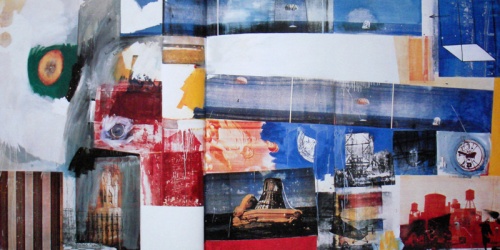Martijn van Berkum, Rotterdam — I step on my balance. It reads 70 kg. I step off and on again. Now it reads 65 kg. Much better. The difference: Robert Rauschenberg. I put aside his catalogue (it’s so heavy) and realise that this 635 pages monster still doesn’t cover his work altogether. How on earth can I weigh the intellectual, creative and visual influence he had on me?
* I think a painting is more like the real world if it’s made out of the real world *
For sure, I could describe his historic importance being one of the first postmodernist artists: looking at the world, at his environment, his country and culture, rather than looking at his canvas only. He was one of the first who brought back the world into art, “the return of the real”, to use Hal Foster’s famous phrase. I could brag on about the way his layered, mixed-media canvasses unfold the intense complexity of life. How they describe a new world of spectacle and entertainment, of chaos and uncertainty.

But that just won’t do it, at least not when such a giant passes away. So, instead, I will have to “return to my reality”. To the time when I had my own inspiring dialogues with Rauschenberg and that was, like so many of his admirers I’d reckon, when I entered the art academy.
Now this is a peculiar moment in life. You find yourself, for the first time ever, alone on unknown territory and just one question burned in my mind: what on earth am I going to do here? All frames of reference that had provided structure to my fragile young life so far were swept away. I had no clue about what art school was supposed to be; I had no clue of what was expected of me. So for want of something to cling to I bought a ridiculously big Rauschenberg catalogue. 635 pages, I thought, that should provide a long-term source of input.
* An empty canvas is full only if you want it to be full *
It’s quite striking, now I come to think of it. In need of order, of something to hold on to, I turned to an artist whose work could be described best as chaotic, layered and uncertain. What good would that do? Nevertheless, despite this paradox, what I needed wasn’t a “regime” of order and discipline to find my way into life at the academy. Instead, I was looking for something that would get me “out there”. What I needed was a Starship Entreprise, a vessel that would take me on a journey and explore unknown worlds and galaxies! And Rauschenberg turned out to be my Jean-Luc Picard: captain and spiritual guide through my private universe of possible artworks. And so we embarked on a journey.
The metaphor of the journey is crucial in this matter, because movement is the only way to discover what art has to offer. You need to touch, smell, look, create and produce heaps and heaps of mediocre drawings, failed silkscreen prints, attempted paintings and then you need to mix them, layer them, cut them up, glue them together, pile them, fold them, burn them, destroy them and start all over again. This dynamic and creative circle of life seems to describe exactly the attitude that Rauschenberg had towards art and that helped me to get through those first years in art school.
* People ask me, “Don’t you ever run out of ideas?” In the first place I don’t use ideas. Every time I have an idea it’s too limiting, and usually turns out to be a disappointment. But I haven’t run out of curiosity *
An actual count of Rauschenberg’s works could provide some clues about his giant production, so I pick up the catalogue again. After 160 pages I’ve counted 200 art works, leaving 475 pages still to go… In a rough estimation that would add up to around 800 works, which is, needless to say, merely a selection, put together 10 years ago. It’s a long shot, but perhaps Mr. Rauschenberg produced roughly 2000 works altogether. Divided by the 56 years of his professional career, that would account for 36 works a year. Slowly inching along myself, I barely manage to produce four projects a year. I guess I still got a long way to go…
* I don’t think there’s anything really wrong with influence because I think that one can use another man’s art as material either literally or just implying that they’re doing that, without it representing a lack of a point of view *
Robert Rauschenberg: a postmodern Da Vinci, dinosaur and space traveller, spiritual father of influence, creativity, inspiration and ‘point of view’.
RIP.